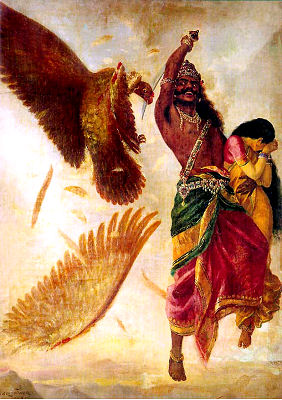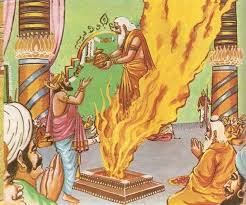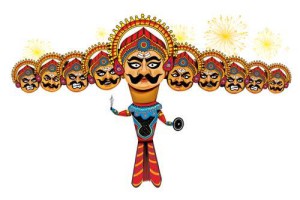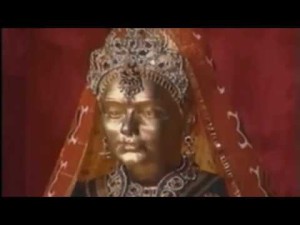Jatayu’s Noble Lineage and Friendship with Dasaratha
Jatayu, the noble king of vultures, was the son of Aruna, the charioteer of Surya, the sun god. He was the brother of Sampati and was closely acquainted with the principles of dharma. Jatayu was a close friend of King Dasaratha, the father of Lord Rama. In his youth, Jatayu and his brother Sampati attempted to reach the sun, but when Jatayu could not withstand the heat, Sampati spread his wings to shield his younger brother, sacrificing his own wings in the process. Jatayu later lived in Panchavati, where he played a crucial role in the epic Ramayana.
The Abduction of Sita by Ravana
One day, the demon king Ravana devised a plan to abduct Sita, the beloved wife of Lord Rama. He sent his brother Maricha to lure Rama and Lakshmana away from their hermitage by assuming the form of a golden deer. Sita, enchanted by the beautiful deer, asked Rama to capture it for her. Rama pursued the deer deep into the forest, leaving Lakshmana to guard Sita. However, when Rama finally killed the deer, Maricha cried out in Rama’s voice, deceiving Sita into thinking her husband was in danger. Sita implored Lakshmana to go to Rama’s aid, and although reluctant, Lakshmana left to find his brother.
Taking advantage of Sita’s solitude, Ravana approached her in the guise of a forest sage. When Sita realized his true identity and rejected his advances, Ravana revealed his true form and abducted her, placing her in his chariot and soaring through the sky towards Lanka.
Jatayu’s Heroic Battle with Ravana
As Ravana was flying away with Sita, Jatayu, the mighty king of vultures, saw them and immediately recognized Sita’s plight. With great courage, Jatayu attacked Ravana, determined to rescue Sita. Jatayu fought fiercely, tearing at Ravana with his talons, beak, and wings, causing the demon king to bleed profusely. The battle was intense, but Ravana, being powerful and determined, eventually took up his sword and severed Jatayu’s wings, causing the valiant vulture to fall to the ground, gravely injured.
Ravana continued on his journey to Lanka with Sita, but before he could reach his destination, Sita threw down her ornaments and pieces of her attire as a sign for Rama and Lakshmana to follow.
Rama’s Discovery of Jatayu
After Ravana’s departure, Rama and Lakshmana returned to the hermitage and found Sita missing. They searched frantically for her, calling out her name. In their quest, they came upon the dying Jatayu, who lay on the ground, his life slowly ebbing away. Initially mistaking Jatayu for a Rakshasa, Rama and Lakshmana prepared to attack, but Jatayu, in his last moments, spoke of his friendship with Dasaratha and recounted the events that had taken place.
Rama, filled with grief and respect for Jatayu’s sacrifice, knelt beside the vulture king. Jatayu, with his dying breath, pointed southward, indicating the direction Ravana had taken. After conveying this crucial information, Jatayu passed away in Rama’s arms.
Jatayu’s Final Rite and Liberation
Rama, deeply moved by Jatayu’s loyalty and bravery, performed the vulture king’s last rites with great reverence. Rama’s act of performing Jatayu’s funeral rites was particularly significant, as it symbolized the deep bond of friendship and respect that transcended species. Jatayu was granted moksha (liberation) and ascended to the heaven of Vishnu in a chariot of fire, a rare and noble end for such a devoted soul.
Lessons to Be Learned from the Story of Jatayu
The Courage to Stand Against Injustice: Jatayu’s heroic attempt to rescue Sita, despite knowing the power of Ravana, teaches us the importance of standing up against injustice, even in the face of overwhelming odds.
Loyalty and Sacrifice: Jatayu’s unwavering loyalty to Rama and his willingness to sacrifice his life for Sita’s safety exemplify the virtues of loyalty and selflessness. His actions show that true devotion often involves personal sacrifice for the greater good.
The Power of Dharma: Jatayu’s adherence to the principles of dharma, even in his final moments, reflects the significance of living a righteous life. His adherence to duty, despite the cost, highlights the importance of dharma in guiding one’s actions.
Divine Compassion: Rama’s deep sorrow and the honor he bestowed upon Jatayu through the last rites demonstrate divine compassion and the respect that the Lord has for all beings who serve Him with devotion and righteousness.
Moksha Through Devotion: Jatayu’s liberation and ascent to Vishnu’s heaven illustrate that sincere devotion and service to the Lord can lead to moksha, regardless of one’s form or status in life.
Prayer for Courage and Devotion
O Lord Rama, embodiment of righteousness, May we always have the courage of Jatayu, To stand against injustice and protect those in need.
Grant us the strength to uphold dharma, Even in the face of great challenges, And to remain loyal and devoted, As Jatayu was to You and Sita.
O Lord, guide us to live a life of virtue, So that we may serve You faithfully, And attain the ultimate liberation, As Jatayu did through his noble sacrifice.
Fill our hearts with compassion and devotion, As You filled Jatayu’s, And may we be ever worthy of Your grace.
Hare Rama, Hare Rama, Rama Rama, Hare Hare, Hare Krishna, Hare Krishna, Krishna Krishna, Hare Hare.



